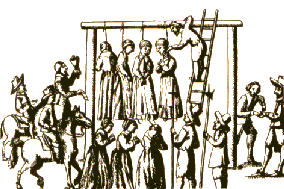


BIOGRAPHICAL NOTES
Francis Faulkner and Abigail Dane
Francis Faulkner was born in May 1651 in Andover, Essex County, Massachusetts, the first of four children of Edmund and Dorothy Faulkner. The household also included a son of Dorothy's from an earlier marriage.
Abigail Dane was born October 13, 1652, also in Andover. She was one of nine children of Francis and Elizabeth (Ingalls) Dane.
Francis Faulkner and Abigail Dane were married in Andover on October 12, 1675. The couple led a fairly well-to-do life due to generous gifts of land from Francis' father before and shortly after the marriage. Francis received a further sizeable inheritance when his father died in 1687.
Meanwhile, the couple had a number of children including two sons and daughters named Elizabeth, Dorothy and Abigail. Various sources provide conflicting information regarding details of the children.
Francis became ill at some point in the late 1680's. Although history shows that he continued to father children, he is reported to have suffered from convulsions, memory loss and impaired understanding. With no adult sons, it fell to Abigail to manage the family estate.
In Puritan New England, it was an uncommon situation for a woman of relatively young age to have control of such wealth. This circumstance may well be at the root of the unfortunate events in Abigail's life that would unfold in the next several years.
The area's famous witchcraft hysteria broke out in nearby Salem Village in 1692. Although people of the time undoubtedly held some belief in the concept of witchcraft, historians generally suggest that the episode was triggered by the restless imaginations of "afflicted" young girls and that accusations of witchcraft were, on some level, fueled by social and political motives. Frequently, those "cried down" as witches had the unfortunate distinction of differing in some respect from the general populace.
Abigail Faulkner, being more financially powerful than many of the men in town, was among those accused of witchcraft when the furor spread to Andover. Also accused were two of her daughters, Dorothy and Abigail, and other relatives. All were arrested and jailed in Salem.
Being accused of witchcraft was an impossible situation. The admission of "spectral" evidence into the trials essentially shifted the burden of proof onto the accused who could do little more than profess innocence. Facing death sentences, some of the accused chose to "confess" their guilt, an action that was interpreted as the first vital step to redemption and could spare one's life. Unfortunately, "confessed" witches were expected to name others involved with witchcraft, an action which fed the vicious circle.
On Saturday, September 17, 1692, Abigail and eight other adults were brought to trial. Among the "evidence" presented against Abigail was the testimony of her daughters who, overwhelmed by their circumstances and presented with leading questions by their examiners, confessed that both they and their mother were witches. All nine of the accused were convicted within three or four hours and condemned to death. Abigail, pregnant at the time, was granted a reprieve until the birth of her child, but remained imprisoned. While most of the others were hanged five days later, Abigail's reprieve bought her enough time to save her life. Eventually, when reason returned to Salem and the witchcraft hysteria died down, Abigail left prison with her newborn baby in her arms.
Being released from prison was merely the first step in recovering from the ordeal. Abigail had been convicted of a crime and sentenced to death; her release merely signified that the sentence was not to be carried out. In the eyes of the law, she was a dead woman. It would take years to fully restore her legal rights and protect the Faulkner estate.
Unlike the nineteen unfortunate souls who refused to confess and were hanged as witches, Francis and Abigail Faulkner lived well beyond the end of the Salem witchcraft trials. They remained in Andover and both died there, she on February 5, 1729/30 and he on September 19, 1732.

Hanging of Four Women
woodcut, 1655
Sources & Related Information